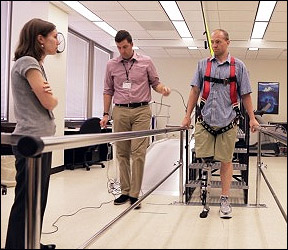A 31-year old software engineer climbed 103 flights of stairs to the top of Chicago’s Willis Tower Sunday, Nov. 4, wearing a prosthetic leg designed by Vanderbilt University engineering professor Michael Goldfarb and adapted by the Rehabilitation Institute of Chicago to become the world’s first neural-controlled bionic leg.
The climb – SkyRise Chicago – is a fundraising event to support RIC’s clinical care and research. The young man participates in a RIC research project to test the “mind-controlled” prosthetic leg.
”] Zac Vawter, from the Seattle area, uses his thoughts to control the one-of-a-kind prosthetic leg that has a powered knee and ankle, the result of a seven-year research effort at the Vanderbilt Center for Intelligent Mechatronics, directed by Goldfarb, the H. Fort Flowers Professor of Mechanical Engineering at Vanderbilt.
Zac Vawter, from the Seattle area, uses his thoughts to control the one-of-a-kind prosthetic leg that has a powered knee and ankle, the result of a seven-year research effort at the Vanderbilt Center for Intelligent Mechatronics, directed by Goldfarb, the H. Fort Flowers Professor of Mechanical Engineering at Vanderbilt.
“Everything went great,” Vawter told the Associated Press at the event’s end. “The prosthetic leg did its part, and I did my part.”
RIC’s Center for Bionic Medicine pioneered the Targeted Muscle Reinnervation (TMR) technique that allows amputees to have more natural control of prosthetic devices. Vawter received the TMR procedure when his leg was amputated after a motorcycle accident three years ago. He became part of RIC’s unique research trial about a year ago, according to a news release from RIC.
Vawter travels to Chicago every few months to test TMR-adapted leg designed to respond to electrical impulses from muscles in his hamstring. What makes it “bionic” is that it interacts with him. When Vawter pushes on the device to stand-up, the device reads his intent and pushes back on him propelling him up, the RIC said.
“One of the biggest differences for me is being able to take stairs step-over-step like everyone else,” said Vawter in RIC’s news release. “With my standard prosthesis, I have to take every step with my good foot first and sort of lift or drag the prosthetic leg up. With the bionic leg, it’s simple, I take stairs like I used to, and can even take two at a time.”
The robotic leg prototype Vawter used Sunday has undergone extensive testing at both Vanderbilt University and the Rehabilitation Institute of Chicago. This work is a result of a grant from The Department of Defense Army’s Telemedicine and Advanced Technology Research Center (TATRC) aimed to improve the control of advanced robotic leg prostheses by adding neural information to the control system.
“We were testing the leg under extreme conditions. Very few patients who will use the leg in the future will be using it for this purpose. From that perspective, its performance was beyond measure,” the RIC’s CEO Joanne Smith said in a Nov. 5 AP story.
According to the NIC, nearly, 3,000 climbers participated in the annual charity event. Participants climbed about 2,100 steps to the SkyDeck level of the Willis Tower, formerly named and still commonly referred to as Sears Tower.